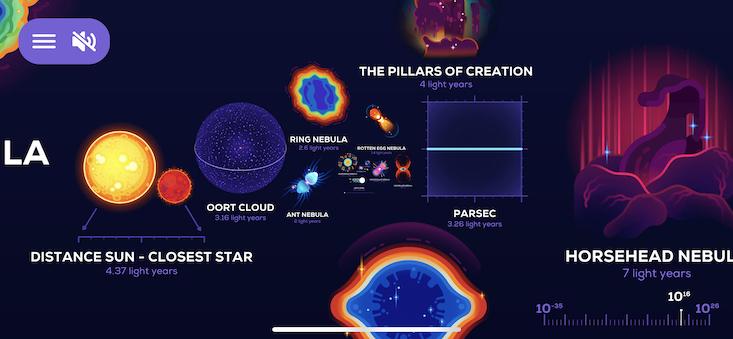
One of the weirdest things about our human experience of the world is how remarkably narrow it can be. We’re equipped with some extraordinary senses for sure. Our visual system can discriminate between some ten million colors and light fluxes that span about 14 orders of magnitude from faint to bright. Our bodies are coated in billions of sensory receptors registering pain, pressure, and temperature, and we have as many as 20 million olfactory receptor neurons, enabling us to distinguish between roughly a trillion different odors.
Yet most of us trundle through our days without feeling a regular existential awe. Perhaps we should. We are, after all, embedded within a physical reality that extends billions of years into an unreachable past and trillions of years into an, as-of-yet, unseen future; or a three-dimensional fabric of space running from 10-34 meters in scale, at the subatomic end, to a span of 1027 meters across the observable universe. We’re also clever little hominins. We have brains that are expert at forming predictive models of the world and imagining realities that seem to exist outside of our impressive, but apparently limited, senses. The trick is in making those imaginings feel like something.
A few years ago, the artist Ron Miller and I made a book called The Zoomable Universe that was in part an homage to earlier, famous efforts like Powers of Ten (which has become a synonym for the whole idea of moving through the size of things), and in part an attempt to capture some of those feelings of cosmic perspective by creating a new version of a journey through all of the physical scales that we think that the universe contains: From the absurd emptiness of the cosmos, so that if you collected all of the universe’s stars together they’d fill a region that is a mere 10-to-the-minus-thirtieth (10-30) of the volume of all observable space. To the similarly impressive inner spaces of matter, where viral nanomachines swarm across cells as if they were planets. An atomic nucleus is a vanishingly small speck at the core of a comparatively vast atom. It was a wild ride, but as a book it was inevitably more static and less tactile than other approaches.
Now the minds behind “Wait But Why” and “Kurzgesagt” have produced a delightful, and decidedly dynamic experience in a new app called “Universe in a Nutshell” that lets you scoot from the subatomic to the cosmic on a screen with the slightest of finger pinches and spreads. As with Stephen Hawking’s 2001 book of the same name, it’s tempting to suppose that this is a clever nod to the famous Hamlet line, “I could be bounded in a nutshell and count myself as a king of infinite space…” In this case, although there have been similar efforts available online, the “Nutshell” app arguably ups the ante a considerable way. It does this through a variety of design approaches. First, the graphics are a terrific mix of stylized representations and lightly animated figures: From bopping bacteriophages to flaring stars. These images flow seamlessly in and out from the center of your screen as you push the scale this way and that.

Tap on any item and you get a succinct description. These texts are a treat, mingling hard facts with witty and intriguing tidbits about the science behind an item and its context. Did you know that Kitti’s hog-nosed bat is the smallest known mammal at a mere 3 centimeters in length, and for that reason known colloquially as the “bumblebee bat”? Or that the Helix Nebula has zombie comets—the remains of once lively star systems now destroyed—inside it? In fact, after enjoying the visceral effect of zooming in and out of the entire universe I found myself methodically stepping through the scales and reading each snippet.
The only catch is that, as numerous as the waypoints are, they’re still just a tiny sampling of all that there could be. This is perhaps always going to be a problem for creative works like these. Physical reality doesn’t just consist of some 60-plus orders of magnitude in scale. It has “stuff” at all scales, whether in discrete objects and phenomena or in structures spanning multiple scales. Capturing that obscene richness and interconnectedness (microbes live on animals that live in oceans than span planets that orbit stars that circulate in galaxies that cluster in swarms that trace the cosmic web of matter) is not easy. There are also all the things that might exist but have not yet been seen or fully understood by us. Subatomic particles of dark matter could be drifting through your eyeball at this very moment, or there might conceivably be bubble universes beyond the horizon of ours. Speculative possibilities could also find a place alongside what we know of the world, or what we think we know.
Like any good version of Powers of Ten, use this app and you can find yourself getting that feeling of cosmic awe—it might take a little attention, but that’s always going to be true. I’m sure that somewhere there is a meditation or mindfulness practice that either already makes use of the concept of cosmic scales or should sign up this app right away as a tool for aiding contemplation. With any luck the makers of “Nutshell” will continue to add some of their quirky and insightful objects and insights, because this is a terrific way to carry the universe around with you.
Caleb Scharf is an astrophysicist, the Director of Astrobiology at Columbia University in New York, and a founder of yhousenyc.org, an institute that studies human and machine consciousness. His latest book is The Zoomable Universe: An Epic Tour Through Cosmic Scale, from Almost Everything to Nearly Nothing. Follow him on Twitter @caleb_scharf.


























